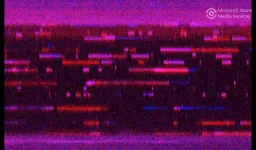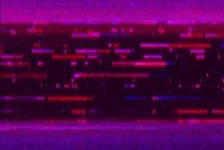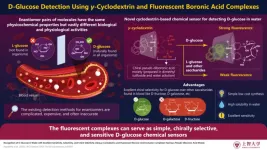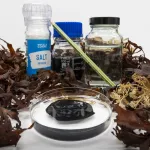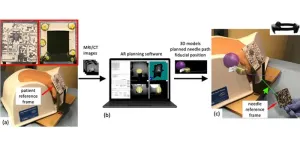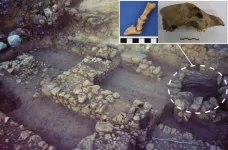(Press-News.org) Tucked away in a small, dark room at UPMC Hillman Cancer Center, Brittani Schnable is on a fishing expedition.
Wielding a joystick similar to those used by video gamers, she casts microscopic beads into an ocean of molecules, pushing and pulling the beads apart until they eventually catch a strand of DNA. After a few taps of the keyboard, a lightshow begins. A burst of colors flashes across the black screen like fireworks exploding in the night sky.
Although these colors seem random at first, a pattern starts to emerge. Lines of blue and red light streak across the screen: A DNA repair protein has bound to the site of damage.
Schnable, a Ph.D. student in Dr. Bennett Van Houten’s lab at the University of Pittsburgh, is using cutting-edge technology called a C-trap that manipulates a single molecule of DNA and a new method — described this week in Nucleic Acids Research — allowing for quick and easy production of proteins for single-molecule visualization. The novel system gives Van Houten and his team an unparalleled level of detail that will help them explore how cells find and repair damaged DNA, information that could someday be used to halt cancer in its tracks.
“I like to think about DNA damage as a pothole,” said Van Houten, Ph.D., professor in Pitt’s Department of Pharmacology & Chemical Biology. “In one particular DNA repair pathway, it takes about 30 proteins to go from finding the pothole to putting in the repair patch. While we can’t observe all of these proteins at once, we can observe them two by two.”
Van Houten’s lab is interested in repair proteins that mend DNA lesions caused by environmental factors, such as ultraviolet (UV) radiation from the sun and environmental pollutants. If these repair pathways break down, DNA damage can contribute to aging, cancer, neurodegeneration and other diseases.
In the new study, the researchers used the C-trap to investigate how different DNA repair proteins identify and bind to their respective forms of damage.
The C-trap system draws on Nobel prize-winning technology called optical tweezers, which use a strong beam of light to grasp and move microscopic beads until they stick to either side of a molecule — in this case a strand of damaged DNA.
“You can move the two beads together and hope that the two DNA ends latch on to each bead like Velcro. When you move the beads further apart, you can actually feel the measure of force of DNA like a spring, or a rubber band,” said first author Matthew Schaich, Ph.D., a postdoctoral fellow in the Van Houten Lab.
Once the DNA bait is set, it’s time to go fishing for proteins.
In collaboration with University of Kent researchers, the Van Houten group developed a new method called Single Molecule Analysis of DNA-binding proteins from Nuclear Extracts, or SMADNE. This technique allows users to create fluorescently tagged proteins much faster and with greater ease than traditional methods. Using SMADNE, the researchers extracted DNA repair proteins from the nucleus of the cell. They then introduced these proteins into the C-trap and analyzed how and when they bound to DNA containing various types of damage.
Interested in the relationship between two particular repair proteins, DDB1 and DDB2, which help repair damage caused by the sun, Schaich watched these proteins popping on and off the DNA as flecks of multicolored light and studied the way they approached and retreated from the site of UV damage.
“You have an area of DNA damage, and you want to know how a cell can identify and fix it,” Schaich explained. “One of the most important things to understand is who gets there first. Once it arrives, does it stay around for the whole repair cascade? Does it hand off repair to a different protein? With the C-trap, you can watch the proteins coming and going and learn a lot about the orders of assembly and disassembly.”
Van Houten thinks about DNA repair proteins like people socializing at a bar.
“Two people walk into a bar. Who goes through the door first? How long do they sit together at the bar, and then who leaves the bar first? DNA repair proteins, like people, are dynamic,” said Van Houten.
The researchers found that when DDB1 and DDB2 were working together at the damage site, they usually arrived at the DNA together and departed together, as expected. Yet, surprisingly, they also saw 11 different association and dissociation patterns with the two proteins arriving and leaving at different times, highlighting the incredible detail that scientists can observe using this new technology.
In addition to DDB1 and DDB2, Van Houten’s team used the C-trap and SMADNE to investigate the activities of a plethora of DNA repair proteins from several different repair pathways in an effort to improve understanding of these repair systems.
By learning how our DNA repair processes work, scientists can better understand how disruptions in these pathways can lead to diseases such as cancer and advance the search for better treatments.
“DNA repair is a double-edged sword,” Van Houten explained. “If you don’t have efficient repair, environmental stressors could cause enough damage that cancer develops. On the other hand, many cancer treatments kill tumors by targeting DNA repair mechanisms.”
Van Houten and his team have applied for a patent for their SMADNE system and will continue to analyze all 30 of the proteins in this UV damage repair pathway.
“The combination of the C-trap and SMADNE has opened up endless opportunities for the study of DNA repair. But what’s the most important question that we can answer using this new tool?” said Van Houten. “To me, it's knowing the precise role of each of the proteins in this pathway.”
Other researchers on the study were Namrata Kumar, Ph.D., Vera Roginskaya and Rachel Jakielski, all of Pitt or UPMC; Roman Urban and Neil Kad, Ph.D., both of the University of Kent; and Zhou Zhong, Ph.D., of LUMICKS.
This work was supported by the National Institutes of Health (R35ES031638) and the Hillman Postdoctoral Fellowship for
Innovative Cancer Research (MAS) and 2P30CA047904 to the UPMC Hillman Cancer Center.
##
END
Fishing for proteins: Scientists use new optical tweezer technology to study DNA repair
2023-03-02
ELSE PRESS RELEASES FROM THIS DATE:
Can’t exercise a particular muscle? Strengthening the opposite side of your body can stop it wasting away
2023-03-02
Loss of muscle strength can be one of the most damaging outcomes when someone is unable to move a part of their body for a long period of time.
But a new Edith Cowan University (ECU) study may have found a way to offset or even protect against this — and it doesn’t even involve the affected body part at all.
Injury or illness may see a part of the body incapacitated for weeks or even months, causing unused muscles to weaken and lose their mass and strength, which can have ...
Physical activity can help mental health in pre-teen years
2023-03-02
Regular physical activity can improve adolescents’ mental health and help with behavioural difficulties, research suggests.
Engaging in regular moderate to vigorous physical activity at age 11 was associated with better mental health between the ages of 11 and 13, the study found.
Physical activity was also associated with reduced hyperactivity and behavioural problems, such as loss of temper, fighting with other children, lying, and stealing, in young people.
Researchers from the Universities of Edinburgh, Strathclyde, Bristol, and Georgia in the United States explored data from the Children of the 90s study (also known as the Avon Longitudinal Study of ...
New fluorescent chiral-selective receptor system represents a breakthrough in molecular detection with potential for applications in diabetes management
2023-03-02
Diabetes mellitus, simply called diabetes, is a metabolic disorder characterized by the presence of abnormally high concentrations of glucose in blood. Existing methods for the diagnosis of diabetes rely on traditional techniques of detecting glucose in blood serum samples—a process that is typically tedious and expensive.
Molecular recognition is the science of accurately detecting specific compounds by exploiting their binding properties. Here, a receptor molecule–a kind of sensor–selectively binds to a target molecule. This process triggers some reaction, say, a change ...
Sleep too much or too little and you might get sick more, scientists find
2023-03-02
A good night’s sleep can solve all sorts of problems – but scientists have now discovered new evidence that sleeping well may make you less vulnerable to infection. Scientists at the University of Bergen recruited medical students working in doctors’ surgeries to hand out short questionnaires to patients, asking about sleep quality and recent infections. They found that patients who reported sleeping too little or too much were more likely also to report a recent infection, and patients ...
Study suggests EHR-focused interventions can significantly reduce unnecessary urine cultures among hospital patients
2023-03-02
Study Suggests EHR-Focused Interventions Can Significantly Reduce Unnecessary Urine Cultures Among Hospital Patients
Initiative highlighted in AJIC provides model for resource-limited institutions to decrease overdiagnosis and overtreatment of asymptomatic bacterial infections
Arlington, Va., March 2, 2023 – Physicians in the largest safety-net hospital system in the United States used two electronic health record (EHR)-focused interventions to significantly reduce inappropriate urine cultures among hospitalized patients. Findings from their study, published in the ...
Edible electronics: How a seaweed second skin could transform health and fitness sensor tech
2023-03-02
Scientists at the University of Sussex have successfully trialed new biodegradable health sensors that could change the way we experience personal healthcare and fitness monitoring technology.
The team at Sussex have developed the new health sensors – such as those worn by runners or patients to monitor heart rate and temperature – using natural elements like rock salt, water and seaweed, combined with graphene. Because they are solely made with ingredients found in nature, the sensors are fully biodegradable, making them more environmentally friendly than commonly used rubber and plastic-based alternatives. Their natural ...
Cocaethylene cardiotoxicity in emergency department patients with acute drug overdose
2023-03-01
Des Plaines, IL — When compared to cocaine exposure alone, cocaine and ethanol exposure in emergency department (ED) patients with acute drug overdose was significantly associated with higher occurrence of cardiac arrest, higher mean lactate concentrations, and lower occurrence of myocardial injury. This is the conclusion of a study titled, Cocaethylene cardiotoxicity in emergency department patients with acute drug overdose published in the February issue of Academic Emergency Medicine (AEM), the peer-reviewed journal of the Society for Academic Emergency ...
Free-hand, real-time needle guidance for prostate cancer diagnosis with augmented reality
2023-03-01
According to the US Centers for Disease Control and Prevention, prostate cancer is the second leading cause of cancer death among men. One of the standard approaches for the diagnosis and treatment of prostate cancer involves transperineal (TP) biopsy. This involves inserting a needle through the perineum wall to collect tissue samples. Current methods for TP biopsy generally include a pre-operation MRI scan and a transrectal ultrasound. These images are then fused together and shown on a monitor to the urologist, who then inserts the needle. The needle insertion can be ...
Special Selection
2023-03-01
A team of global experts has discovered new signals of natural selection in humans.
Led by UC Santa Barbara Tsimane Health and Life History Project co-director Michael Gurven, the team studied two populations living in the Bolivian Amazon rainforest — the Tsimane and the Moseten. Previous studies show that these tropical populations are exposed to many parasites and a variety of pathogens; at the same time, the Tsimane rarely suffer from cardiovascular diseases and dementia. This new research suggests that the Tsimane genome has undergone selection ...
Bronze Age well contents reveal the history of animal resources in Mycenae, Greece
2023-03-01
A large Bronze Age debris deposit in Mycenae, Greece provides important data for understanding the history of animal resources at the site, according to a study published March 1, 2023 in the open-access journal PLOS ONE by Jacqueline Meier of the University of North Florida and colleagues.
Animals were an important source of subsistence and symbolism at the Late Bronze Age site of Mycenae in Greece, as evidenced by their depictions in art and architecture, but more research is needed on the animals ...
